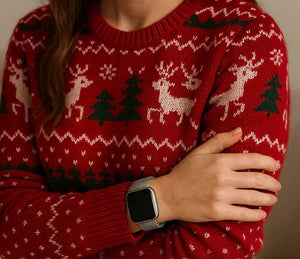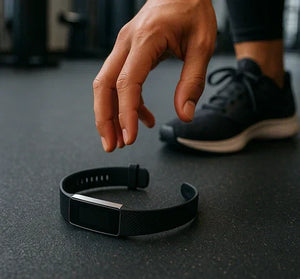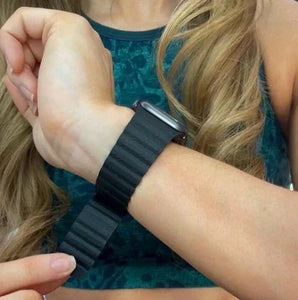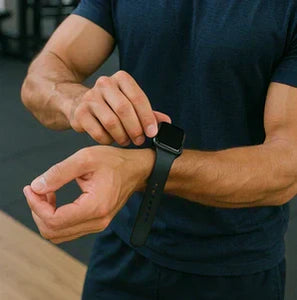As wearable tech lovers, we’ve all been there, your Apple Watch either hugs your wrist too tightly or slides around like it’s had one too many coffees. No fun for anyone, right? The right fit isn’t just about comfort. It’s about accuracy and feeling good every time you take a peek down at your wrist.
In this guide, we’ll walk you through how to adjust your Apple Watch band properly, with no faff or fancy jargon. Just quick and clear steps so you can get that perfect fit. Whether you’ve got a Sport Loop, a Milanese, or a Link Bracelet, we’ve got you covered here at Fitstraps.
Let’s sort that fit out once and for all.

Getting to Know Your Watch Strap for Your Apple Watch
Before you start fiddling with your watch band, it helps to know what you’re working with. Not every band adjusts in the exact same way, and trust us, a little know-how can save you a lot of hassle.
Apple has a few main types in their range. The Sport Band and Sport Loop are your everyday go-tos, flexible and specially made for quick adjustments. The Solo Loop skips buckles and pins completely, stretching to slide on and off your wrist. Then there’s the Milanese Loop, sleek and magnetic, giving you that smooth, almost effortless fit. The Link Bracelet feels more like a traditional watch, solid, clicky, and best resized with Apple’s tool. And of course, their Leather Band, where comfort meets style, moulding to your wrist’s shape over time.
Each design looks simple on the surface, but Apple builds them with a sneaky amount of precision. Once you understand how yours works, adjusting it can actually feel intuitive and even satisfying. Get this step right, and the next part’s an absolute breeze.

Finding That Perfect Fit
So, what does a “perfect fit” actually feel like? It’s that sweet spot where your watch stays put without digging into your skin around your wrist. You shouldn’t see any red marks, but it also shouldn’t wobble around when you move your wrist about. If it slides around or feels pinchy, it’s off.
Here’s the thing, though, it’s not just about comfort. The fit directly affects how your Apple Watch tracks your heart rate and your workouts. Too loose, and the sensors lose contact. Too tight, and your wrist starts protesting halfway through the day.
When you’re working out, we recommend going for a slightly snugger fit. It keeps the sensors steady while you’re moving. Once you’re done you can loosen it a touch for everyday wear.
Now that you know what a good fit feels like, let’s get into how to nail it with each band.

Adjusting Apple Watch Band Like a Pro
Alright then, let’s talk about adjusting your band like a pro. Each watch band in Apple’s range has its own vibe, and once you get the hang of how it connects to the watch case size, it all starts to make sense. Before you even begin, place your watch on a clean surface. It keeps things steady and helps you avoid damaging the band or case while you go to work.
Let’s start with the Sport Band and Sport Loop. They’re easy-going and built for everyday use. Pop the pin out and move it through the adjustment holes until it feels right. If you’ve got a loop, just hold the end and slide the strap until it sits snug. You should be able to slide one finger under it, not two. That means you’re close to perfect. If it’s the wrong size, you’ll feel it within minutes, too tight or slipping around on your wrist.
Now, the Milanese Loop. That magnetic clasp is a dream once you get used to it. Lift it up gently, slide the band through the slot, then let the magnet fall back into place. It should feel soft but secure. If it moves while you’re walking, make a small tweak. Don’t force it; that magnet’s strong enough to stay put once it’s attached.
Next up, the Link Bracelet. This one’s where precision meets patience. Each link connects with tiny release buttons. Press them gently, and you’ll hear a clean click when one comes loose. Remove or add links from one side at a time to keep the balance even. If you’re purchasing a new watch band, make sure it’s compatible with your specific watch’s case size; that’s a common mistake we hear about again and again.
Then we’ve got the Solo Loop. No pins, no buckles involved, just one continuous piece. Getting the fit right here is everything. If it feels tight, give it a few days to stretch. If it’s still feeling a little off, it’s time to order a different size. Apple’s sizing guide helps you check before you buy.
Once everything feels good, give your Apple Watch face a quick wipe with a lint-free cloth. Try it on again and enjoy the comfort. If you ever change your band, just follow the same steps; it’s easy once you’ve done it a few times.
👉If your current band doesn’t sit quite right, explore our full range of replacement options for the Apple Watch built for adjustable comfort.

When to Rethink Your Band Choice
Sometimes, no amount of tweaking will fix the real problem; your watch band just isn’t the right match. It happens. Maybe it keeps rubbing after a few hours, or it feels heavy when you’re on the move. Everyone’s wrist is different, and things like wrist shape and skin sensitivity can change how a band feels.
If you feel yourself constantly taking it off or adjusting it, that’s your cue. Think about how you use your smartwatch. If you are active, a Sport Band or Sport Loop works much better, is super lightweight and breathable. If you wear it mostly at work or out to dinner, leather or Milanese adds a touch of class to your tech without shouting for attention.
And don’t forget, it’s not just a band, it’s part of your look. The colour, texture, and clasp say something about you. Switching it up now and then keeps things fresh. A different band can change how your whole watch feels, and how you feel wearing it.
Caring for Your Band After the Perfect Fit
Once you’ve nailed the fit, keeping your Apple Watch band in top shape is all about some small, consistent habits. A bit of care goes a long way.
Start by cleaning your watch band. Sweat, dust, and skin oils build up faster than you think. Give it a quick wipe down every few days with a soft, damp cloth, nothing fancy. If it’s leather, skip the water and use a dry cloth instead. Let it breathe. For metal bands, check the clasp and links now and then to make sure everything still feels smooth and secure.
Make sure that you store it right too. When you’re not wearing your watch, place it somewhere cool and dry. Avoid leaving it in direct sunlight or a steamy bathroom. It sounds obvious, but those small things can wear it out faster.
Every few months, check the fit again. Your wrist can change with the weather, or just with time. Readjust if needed; it only takes a minute.
A well-cared-for watch band doesn’t just last longer; it feels better every time you wear it. And when it fits right and looks clean, it’s a small detail that makes your day feel a bit more put together.

The Subtle Power of a Good Fit
It’s funny how something as small as a watch band can make such a big difference. When your Apple Watch fits just right, everything feels much smoother. You move more freely. The sensors track better than ever. And you stop fiddling with it every few minutes, it simply becomes part of your setup.
A good fit isn’t just about tech or comfort; it’s about confidence. You wear your watch every day at work or in the gym, so it should feel like it belongs there at all times. When it sits right on your wrist, it disappears in the best way possible.
So, always take a few minutes to get it right. Adjust, swap, or experiment until you find what works best for you. It’s not about being perfect, it’s about finding the right balance.
In the end, it’s the little details, the fit and the feel that make your Apple Watch experience feel complete. You’ll know when it’s right. It just clicks.
👉Need a better fit? Discover our range of fully adjustable Apple Watch-ready wristbands that make it easy to fine-tune your strap for all-day wear
 Do Apple Watch Straps Fit Other Watches?
Do Apple Watch Straps Fit Other Watches?
 Best Apple Watch Band for CrossFit: The Complete Guide for Serious Training
Best Apple Watch Band for CrossFit: The Complete Guide for Serious Training
 Finding the Best Fitbit Band for Sleeping
Finding the Best Fitbit Band for Sleeping
 Finding a Christmas Apple Watch Strap: Celebrate the Season in Style
Finding a Christmas Apple Watch Strap: Celebrate the Season in Style
 Why Does My Fitbit Strap Keep Falling Off?
Why Does My Fitbit Strap Keep Falling Off?
 Adjusting Your Apple Watch Band For A Better Fit
Adjusting Your Apple Watch Band For A Better Fit
 Are Apple Watch Straps Dangerous?
Are Apple Watch Straps Dangerous?




